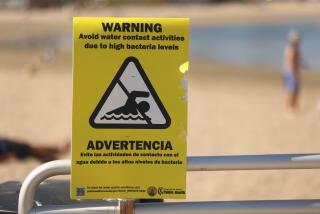L.A. County Beaches Were State’s Most Unhealthful This Summer
Los Angeles County coastal waters this summer contained the highest levels of harmful bacteria measured during the last five years, accumulating more failing grades for human health standards than any other swimming beaches in California.
The popular Surfrider Beach in Malibu and Cabrillo Beach in the backwaters of San Pedro Bay were on the list, as they have been for the last several years.
Extraordinarily high bacteria counts also surfaced throughout the summer in the near-shore waters next to the Santa Monica and Redondo Beach piers, just off Dockweiler and Will Rogers state beaches, and along the more isolated beaches at Latigo Point and Paradise Cove -- despite millions of dollars spent on cleanup.
None of this came as a surprise to surfers such as Cory Bleumling, a Cal State Northridge graduate student who recently experienced head congestion, chills and diarrhea after one surfing session.
“It’s always a little nasty out here, a bit of funk,” Bleumling said Wednesday, emerging from the surf at Malibu, a longboard tucked under his arm. Every time he paddles out, he said, there’s some health risk. “It’s like going to Mexico. You might get sick, or you might not.”
The failing grades, compiled by nonprofit environmental group Heal the Bay, were recorded as Los Angeles County and its cities face a state deadline of July 31 to make waters healthful for swimming every day during the summer -- or face hefty fines.
The unhealthful conditions are blamed on multiple sources, including sewer spills, pet waste, fertilizer, oil and other pollution washing off lawns and pavement and ultimately into the sea.
“The city needs to make this its top environmental priority, said Los Angeles Councilman Jack Weiss. He noted that Los Angeles voters overwhelmingly endorsed $500 million in bonds to clean up city waterways and coastal waters. “We need to keep faith with them and keep faith with the [Clean Water] law.”
Los Angeles County is considering its own bond measure to step up its effort, officials said.
“We’ve been attacking runoff pollution on several fronts, including public education and enforcement of illegal dumping” laws, said Ken Pellman, a spokesman for the Los Angeles County Department of Public Works. “The least expensive way to clean up beaches and ocean water is to change public behavior.”
Relying mostly on state grants, local governments have already spent millions of dollars installing devices that divert and treat “urban slobber,” the steady trickle of bacteria-laden water that runs down storm drains and creeks from urban centers.
Some of the low-flow diversions were improperly designed, poorly situated or are not maintained, said Mark Gold, at a news conference Wednesday in front of a stream of water washing onto Will Rogers State Beach from Santa Monica Canyon. Gold is executive director of Heal the Bay.
Standing before television cameras, he said that the diversion project for the canyon’s storm drain is “dramatically undersized. It’s not just as simple as setting up the diversion. You have to make sure they are the appropriate size and location.”
State and local officials acknowledged Wednesday that they have made mistakes and need to relocate or enlarge some diversion dams.
Government officials and environmental activists have found this summer’s high bacterial levels perplexing.
“It was, by far, the most polluted year we have ever seen in the past five years,” said Gold, who helps analyze bacterial levels and grading of beaches from A to F.
Gold said he initially blamed the failing grades on record rainfall. Raging storm water routinely overwhelms or breaks sewer lines, releasing raw sewage into the ocean.
Storm-water runoff also augments the flow of urban pollutants into the ocean.
But other Southern California counties, from Santa Barbara to San Diego, also experienced record rainfall and still showed improvement this summer in keeping bacterial levels below federal and state health standards, Gold said.
Furthermore, he said, the beaches with the highest bacterial counts were spiking off and on all summer, not just during the first months after the heavy winter rains.
Overall, nearly 20% of beaches in Los Angeles County received grades of D and F, while 57% received A’s, 18% received Bs and 5% Cs. By comparison, only 2% of Orange County beaches received Ds and Fs, and 1% of San Diego County beaches. No beaches in Ventura or Santa Barbara counties got failing marks.
Heal the Bay issues grades based on bacterial counts for total coliform, a rough indicator of decay, and fecal coliform and enterococci, associated with human sewage and the excrement of warm-blooded animals.
The grades are an approximation of the risk of getting sick from polluted waters, usually with respiratory or gastrointestinal illness.
Health officials recommend avoiding ocean waters within 100 yards of a flowing storm drain or stream.
More to Read
Sign up for Essential California
The most important California stories and recommendations in your inbox every morning.
You may occasionally receive promotional content from the Los Angeles Times.










